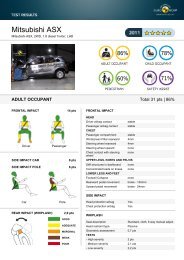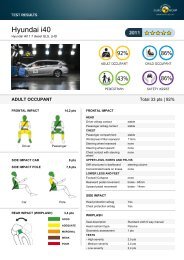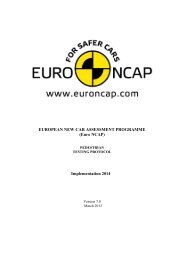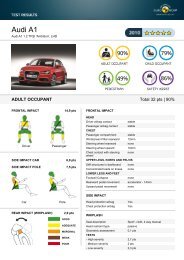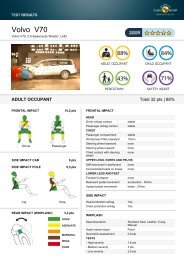Whiplash Testing Protocol - Euro NCAP
Whiplash Testing Protocol - Euro NCAP
Whiplash Testing Protocol - Euro NCAP
Create successful ePaper yourself
Turn your PDF publications into a flip-book with our unique Google optimized e-Paper software.
5.3.21 When each foot is in its final position, the heel shall be in contact with the floor, and the sole<br />
of the foot shall be in contact with the 45 degree plane of the toe pan between the 230mm and<br />
270mm lines.<br />
5.3.22 If the HPM is not level after the feet have been repositioned, a sufficient load shall be applied<br />
to the top of the seat pan to level it on the vehicle seat. This may be verified using the bubble<br />
gauge fitted to the manikin or alternatively by verifying with CMM that the H-point position<br />
on both sides of the machine are within ± 2.5mm of each other.<br />
5.4 Installation of the HRMD<br />
5.4.1 The backset and height probes shall be installed and pushed flush against the HRMD.<br />
5.4.2 The HRMD levelling knob shall be confirmed as finger tight and the plungers which engage<br />
at the HPM to HRMD interface shall be fully loosened.<br />
5.4.3 The HRMD shall then be lowered into position on the HPM torso weight hangers and on the<br />
top edge of the channel between the hangers. During the fitment, ensure that the HRMD fits<br />
easily into place without inducing forces which might disturb the manikin position. Make<br />
note of any longitudinal movement of the manikin, and ensure that this results in consistent<br />
H-point position in the subsequent repeat drops conducted in section 6.5.<br />
5.4.4 The HRMD shall be levelled by loosening the levelling knob at the rear of the device and<br />
repositioning the head using the HRMD bubble level; the levelling knob shall then be<br />
retightened by hand.<br />
5.4.5 Measure the torso angle on the calibrated block attached to the weight hanger bar.<br />
5.4.6 If the measured angle is not 25°±1°, the HRMD and chest and buttocks weights shall be<br />
removed, the seat back readjusted, and the steps to position the HPM shall be repeated,<br />
beginning with tilting the back pan forward and pushing the HPM rearward as in 5.3.10.<br />
5.4.7 If more than 3 installations of the HPM and HRMD are required to ascertain a seatback angle<br />
that supports a torso angle of 25°±1°, then the seat should be allowed to recover for 15<br />
minutes with nothing in it between each third and fourth installation. It is recommended to<br />
aim to set the SAE manikin as close as possible to the nominal target value for torso angle.<br />
5.4.8 Some indexed seatback adjustments may have more than 2° between adjustments with none<br />
giving a torso angle between 25°±1°. In such cases, adjust the seatback to the most reclined<br />
position that supports a torso angle less than 24°.<br />
5.4.9 The torso angle shall be recorded when it falls within the allowed range.<br />
5.5 Record the location of the HPM H-point markers.<br />
5.5.1 Record the H-point positions on both sides of the HPM using a CMM or other means to<br />
record the location of both H-points relative to the seat or sled.<br />
Version 3.1<br />
June 2011<br />
16



